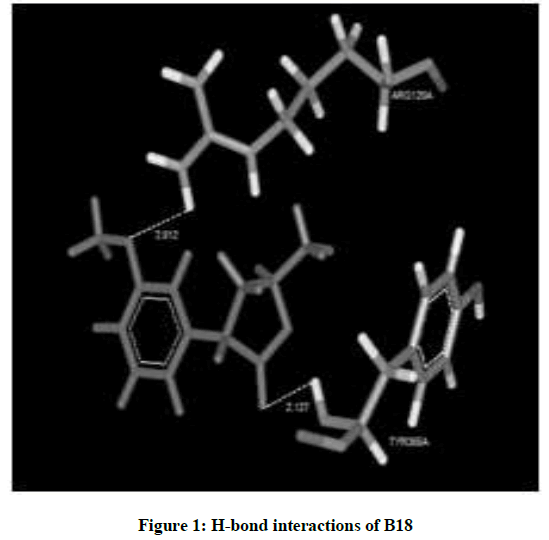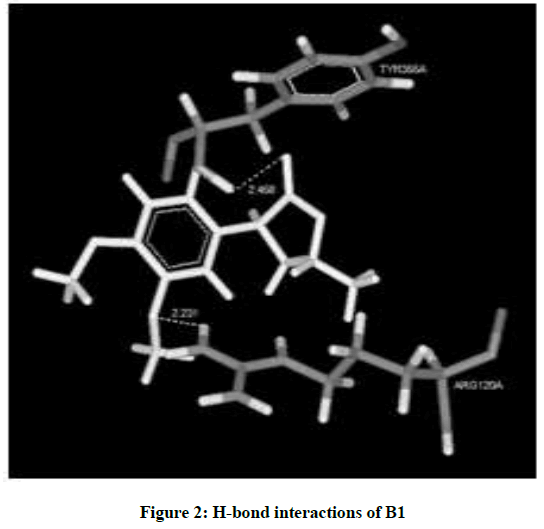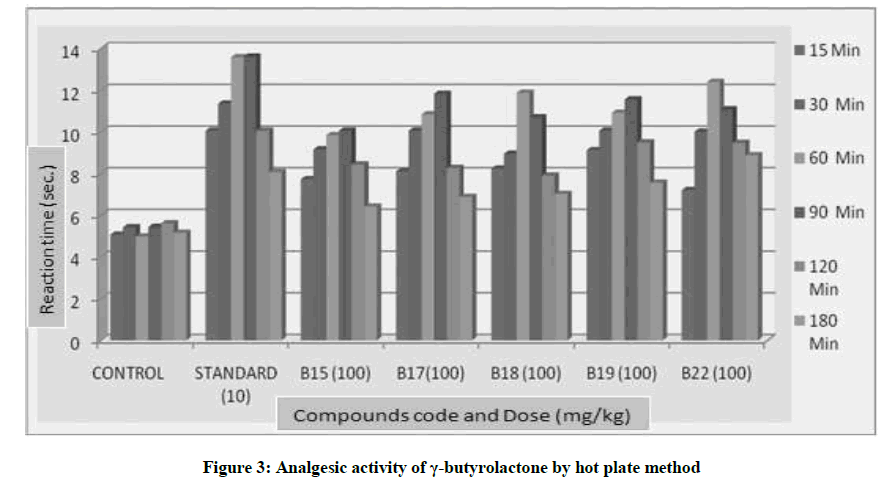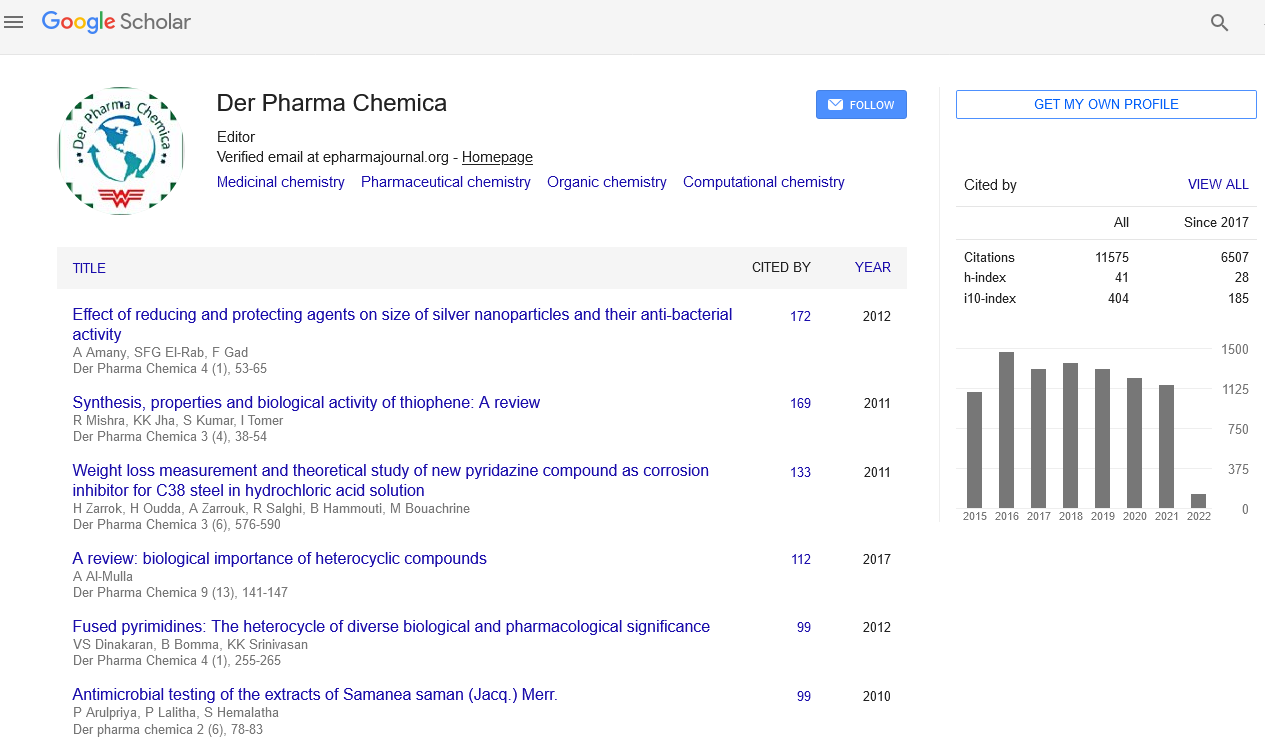Research Article - Der Pharma Chemica ( 2018) Volume 10, Issue 1
Design, Synthesis and Studies of Structure Activity Relationship of Îó-butyrolactones for Evaluation of Analgesic Activity
Anuruddha R Chabukswar1*, Bhanudas S Kuchekar1, Pradeep D Lokhande2, Swati C Jagdale1, Vishnu P Choudhari1, Vasant V Chabukswar3, Jaiprakash N Sangshetti4, Atul A Baravkar5, Nitin S Shinde6, Mayuri N Mohokar1 and Sunit R Bhagade1
1Department of Pharmaceutical Chemistry, MAEER’s Maharashtra Institute of Pharmacy, MIT Campus, Paud Road, Kothrud, Pune-411038, MS, India
2Department of Chemistry, Savitribai Phule Pune University, Pune 411 007, India
3Nowrosjee Wadia College, Pune-411 001, India
4Y.B. Chavan College of Pharmacy, Aurangabad, India
5Shree Wagheshwar Gramvikas Pratishthan’s College of Pharmacy, A/p-Madavgan Pharata, Tal-Shirur, District Pune, India
6Department of Chemistry, Shardabai Pawar Mahila Mahavidyalaya, Malegaon Bk. Tal, Baramati District, Pune, India
- Corresponding Author:
- Anuruddha R Chabukswar
Department of Pharmaceutical Chemistry
MAEER’s Maharashtra Institute of Pharmacy, MIT Campus
Paud Road, Kothrud, Pune-411038, MS, India
Abstract
Substituted Phenyl acetic acids have been used for the synthesis of various γ-butyrolactone. γ-butyrolactone compounds were designed by docking studies with cycloxygenase II active site. Thirteen compounds of γ-butyrolactone have been synthesized, characterized and subjected for analgesic activity in mice by hot plate method. Some of the compounds have been found to show better hydrogen and hydrophobic interactions with the cyclooxygenase enzyme. Out of 13 compounds 05 compounds have shown significant analgesic activity and can serve as future potential to be active as analgesic agents by inhibiting cyclooxygenase II enzyme. It has been observed that the analgesic activity of the compounds depends on the structure activity relationship of certain functional group. Structure activity relationship studies shows that by introduction of groups like halogens, hydroxyl and methoxy group plays a prominent role in enhancing analgesic activity of the substituted butyrolactones.
Keywords
Analgesic, γ-butyrolactones, Cyclooxygenase, Hot plate method, Phenyl acetic acid
Introduction
Gamma-Butyrolactone (GBL) is a well known class of natural products showing significant biological activities like anticancer [1], antimycobacterial [2], anti-inflammatory, analgesic [3], antiproliferative, vasoralxing activities [4]. Some of the structurally similar compounds to GBL like Gamma Hydroxy Butyric Acid (GHB) have exhibited anticonvulsant activity used for the tratment of cataplexy in patients with narcolepsy [5,6]. Some derivatives of GBL possess anticonvulsant and analgesic activity [7-9]. Many mono-, bi- and tri-substituted monocyclic γ-butyrolactones are known, to occur naturally. Presently available Non Steroidal Anti-inflammatory (NSAIDs) drugs are commonly used as analgeics for the treatment of mild to moderate pain. However extensive use of NSAIDs has certain disadvantages like GI irritation, bleeding and ulceration. In case of opioids analgesics dependence and serious adverse effects are observed. Hence there is a need to find the new compounds which can be used as alternative to existing drug molecules [10]. Litearture studies shows that very few data is available on analgesic activity of butyrolactones. GBL is a precurrsor for GHB and in literature it has been mentioed that some substituted γ-butyrolactone may be involved in the analgesic activity [11]. However very few work has been carried out on exploring the analgesic activity of γ- butyrolactones. In view of the reported diverse range of pharmacological activities of γ-butyrolactones and their role as analgesic agent we have decided to design and synthesize novel γ-butyrolactone derivatives to explore their potential analgesic activity. Present work deals with structure activity relationship studies of various phenyl substituents at positin 3 of γ-butyrolactone and analysis of their docking interactions with the cyclooxygenase enzyme. Analgesic activity is evaluated by hot plate method in mice.
Materials and Methods
Molecular modeling is performed on a Pentium IV computer (CPU at 2.8 GHz) with Windows XP operating system using V-Life Sciences MDS Software. Melting points were determined with Veego melting point apparatus. Rf value was calculated for compounds using n-hexane: Ethyl acetate (9.0:1.0) as mobile phase. IR spectra in KBr were recorded on a FTIR Spectrophotometer with Diffuse Reflectance Attachment (Varian 680). 1H-NMR spectra were obtained using Varian Mercury YH 300 Spectrometer. Analgesic activity was performed on Mvtex Analgesiometer.
Chemistry
Compounds have been synthesized as per the Scheme 1 for 5-(methyl)-3- phenyldihydrofuran-2-(3H)-one (d). (0.01 mol) of compound (a) was refluxed with 10 ml methanol and 2-3 drops of sulfuric acid for 5 h to (b) Followed by addition reaction with the help of allyl bromide and potassium bicarbonate at room temperature to form intermediate (c) followed by cyclisation reaction with Dimethyl Sulfoxide (I2-DMSO) solution and heating it to give 5-(methyl)-3-phenyldihydrofuran-2-(3H)-one (d). The synthesis starts with esterification of phenyl acetic acids (a) with methanol in presence of sulfuric acid. The esters of phenyl acetic acid were alkylated by using allyl bromide in the presence of anhydrous potassium carbonate at room temperature. Final step is the lactonisation of allyl esters by using catalytic amount of molecular iodine in DMSO solvent at 90°C which affords substituted γ-butyrolactone (d). It was found that the first step of reaction proceed well at 60°C with concentrated sulfuric acid. After each step, washing of the product was done with ethyl acetate and water. Product was found in organic layer after evaporation. Compounds have been characterized by spectral analysis like IR, 1H-NMR and Mass spectra (Table 1).
| Sr. No. | Comp. Code | R2 | R3 | R4 | R5 | R6 | Mol. Wt. | % Yield | Boiling point (°C) | Rf value |
|---|---|---|---|---|---|---|---|---|---|---|
| 1. | B1 | H | H | H | H | H | 176.21 | 80.00 | 204-206 | 0.59 |
| 2. | B14 | OH | H | H | H | H | 192.21 | 83.71 | 178-180 | 0.56 |
| 3. | B15 | H | Cl | H | H | H | 210.65 | 73.95 | 192-194 | 0.48 |
| 4. | B16 | H | CH3 | H | H | H | 190.23 | 71.46 | 164-166 | 0.61 |
| 5. | B17 | H | OH | H | H | H | 192.21 | 81.16 | 182-184 | 0.55 |
| 6. | B18 | OCH3 | H | H | H | H | 206.23 | 78.26 | 200-202 | 0.63 |
| 7. | B19 | H | OCH3 | OCH3 | H | H | 236.26 | 68.21 | 196-198 | 0.54 |
| 8. | B20 | CH3 | H | CH3 | H | CH3 | 218.29 | 74.33 | 176-178 | 0.49 |
| 9. | B21 | H | H | Br | H | H | 255.10 | 82.23 | 186-188 | 0.58 |
| 10. | B22 | Br | H | H | H | H | 255.10 | 84.25 | 194-196 | 0.62 |
| 11. | B23 | H | OCH3 | H | H | H | 206.23 | 80.51 | 202-204 | 0.53 |
| 12. | B24 | H | H | H | C2H5O | H | 220.26 | 69.79 | 168-170 | 0.59 |
| 13. | B25 | H | OCH3 | OCH3 | OCH3 | H | 266.28 | 68.89 | 172-174 | 0.57 |
Table 1: Physical data of synthesized derivatives
Pharmacological studies
Acute toxicity studies
The animals were fasted for 24 h prior to the experiment and up and down procedure [12]. Organisation for Economic Co-operation and Development (OECD) guideline no. 425 Newly synthesized compounds suspended in 0.5% w/v Carboxy Methyl Cellulose (CMC) suspension and administered to groups of mice (n=6) upto a dose level of 2000 mg/kg b.w. p.o. Animals were placed individually in plastic cages and observed at least once daily for the first 30 min and periodically for 24 h to observe for signs of toxicity, compounds have been found to be safe upto dose level of 2000 mg/kg. From the acute toxicity studies the doses of 100 mg/kg was selected for further evaluation analgesic activity.
Analgesic activity by Hot plate test
For the analgesic activity, adult female Albino Swiss mice weighing 25-30 g were used [13]. The animals were kept in group of 6 mice in cages at temperature conditions of 22 ± 2°C, under a light/dark cycle and feeded well during storage. Each experimental group contained 6 animals and animals were kept on starvation for 20 h before experiment. The protocol for experiments was approved by Institutional Ethics Committee. In hot plate test mice were treated orally with the synthesized compounds (dose 100 mg/kg) and Standard group with standard Pentazocine (10 mg/kg; i. p.) and the control group with vehicle 15 min before being placed on a hot plate apparatus Mvtex Analgesiometer with temperature controlled at 55 ± 0.5°C. The latency to first sign of hind paw licking or jump response to avoid heat nociception was taken as an index of nociceptive threshold with cut off time of 15 sec with the help of stop watch. The nociceptive threshold was observed at 15, 30, 60, 90, 120, 180 and 240 min after administration. Analgesic activity of the test compounds were compared with respect to control. Data was analyzed by Student’s t-test for n=6 (P value<0.01).
Docking method
Cyclooxygenase-2 (COX-2) Protein Data Bank (PDB Code: 4COX) co-crystallized with Indomethacin as reference ligand was retrieved from the PDB. GRIP docking is done further on selected minimize energy conformers. V-life sciences software was used for the docking studies.
Results and Discussion
The binding energy studies show favorable binding of selected ligands to the COX-2 enzymes. All the amino acids residues present in the active site of COX-2 enzyme were involved in the interactions with ligand. Compounds B15, B18 and B19 showed hydrogen bond interactions with Tyr355a, ARG120a residues. Reference ligand also exhibited interaction with similar amino acids residues at approximately similar inter atomic distances. Compound B15 shows binding of one hydrogen bond between O from C=O and Tyr355a with distance 2.231. Compound B18 forms 2 hydrogen bond interactions (Figure 1). One between methoxy group and ARG120a of distance 2.812 and another between O from C=O and Tyr355a of distance 2.127. Similarly Compound B19 (Figure 2) showed 2 hydrogen bond interactions of which one is between ARG120a and one methoxy group of distance 2.231 and one hydrogen bond between O from C=O and Tyr355a of distance 2.458.
Compound No. B17 and B22 also showed better binding with hydrophobic interaction and exhibited favorable interactions with the amino acid residues. The docking interactions suggests that introduction or substitution of halogens at position 2nd (B22) and 3rd (B15) shows better binding to active site. Similarly substitution of hydroxy group at 3rd position (B17) is important for interaction with amino acids residues. Substitution of methoxy group at 2nd, 3rd and 4th position (B18 and B19) also exhibited better binding in docking studies.
Docking studies were used to design the compounds for studying their docking interaction with cyclooxygenase enzyme. Synthesis was performed by using various substituted phenyl acetic acid derivatives. It was found that the first step of reaction proceed well at 60°C with concentrated sulfuric acid. In the final step the temperature conditions were 80°C to get the single product. After each step, washing of the product was done with ethyl acetate and water. Product was found in organic layer after evaporation. Compounds have been characterized by spectral analysis like IR, 1H-NMR, Mass spectra and elemental analysis (Table 1).
All of the synthesized derivatives contain characteristic functional groups for IR in the ranges of 3010-3100 cm-1 for CH stretching in aromatic ring, 2200-2500 cm-1 for methyl group on cyclopentanone ring, 1690-1760 cm-1 for C=O group, 1500-1600 cm-1 for C=C and 1050-1300 cm-1 for C-O group in cyclopentanone ring. The synthesized derivative shows NMR values in the ranges of δppm=7-8 for aromatic ring and δppm=2- 5 for cyclopentanone ring.
In the analgesic studies (Figure 3) it has been observed that the compounds substituted with halogens, hydroxyl and methoxy group shows significant analgesic activity. The compounds are found to increase in reaction time to the pain stimulus. The results are significant at P<0.01 (Table 2). Compounds may act by inhibiting the COX enzymes by blocking the synthesis of prostaglandins which evoke inflammatory responses. The compounds are thus useful as analgesics in pain management. Structure activity relationship studies are thus helpful in designing the compounds for better analgesic properties.
| Comp Code/Dose (mg/kg) | Basal reaction time (s) | Reaction time(sec) | |||||
|---|---|---|---|---|---|---|---|
| 15 min | 30 min | 60 min | 90 min | 120 min | 180 min | ||
| Control | 4.068 ± 0.3420 | 5.073 ± 0.3404 | 5.427 ± 0.0799 | 4.982 ± 0.1557 | 5.441 ± 0.1407 | 5.615 ± 0.1349 | 5.163 ± 0.2383 |
| Standard (Pentazocine) (10) | 5.180 ± 0.1233 | 10.065 ± 0.1780** | 11.368 ± 0.5459 ** | 13.583 ± 0.3220 | 13.617 ± 0.3385** | 10.063 ± 0.1117 ** | 8.077 ± 0.3338** |
| B15 (100) | 5.434 ± 0.4768 | 7.732 ± 0.7036** | 9.168 ± 0.6119** | 9.843 ± 0.1607 | 10.062 ± 0.3798** | 8.445 ± 0.5020** | 6.422 ± 0.2276 |
| B17 (100) | 4.892 ± 0.2342 | 8.117± 0.683** | 10.063 ± 0.2636** | 10.842± 0.7279 | 11.832± 0.7655** | 8.278 ± 0.2732** | 6.880 ± 0.1643** |
| B18 (100) | 5.064 ± 0.3123 | 8.240± 0.2863** | 8.952 ± 0.2249** | 11.883± 0.5778 | 10.702± 0.1370** | 7.915± 0.3529** | 7.027 ± 0.2096** |
| B19 (100) | 5.145 ± 0.2454 | 9.120 ± 0.0575** | 10.067 ± 0.2712** | 10.925 ± 0.2119 | 11.565 ± 0.2935** | 9.540 ± 0.2543** | 7.565 ± 0.3867** |
| B22 (100) | 5.342 ± 0.3650 | 7.215 ± 0.1051** | 10.012 ± 0.3832** | 12.400 ± 0.5987 | 11.082 ± 0.5596** | 9.472 ± 0.3893** | 8.887 ± 0.4539** |
Table 2: Analgesic activity of γ-butyrolactone
5-(methyl)-3- phenyldihydrofuran-2-(3H)-one (B1): Yield: 80%; b. p. 204-206°C. IR (KBr) 3028.51 (N–H); 1721.93 (C=O, cyclic); 1456.13 (C-H, CH3, def); 1153.76 (C-O, cyclic). 1H-NMR (300 MHz, CDCl3, d ppm): 1.224-1.242 (d, 3H, J=7.2Hz); 2.485-2.479, 2.901-2.921 (dd, 1H, J1=8.4, J2=8.0, Cyclopentanone ring); 3.715-3.734 (t, 1H, J=7.6, Cyclopentanone ring); 4.381-4.585 (sixlet, 5H, Cyclopentanone ring); 7.217- 7.459 (m, 4H, Ar). Mass spectra of compound exhibited molecular ion peak at m/z 176(M+). Anal. Cal. for C11H11O2 (176.21): C, 74.911; H, 6.243; O, 18.16%, found: C, 76.721; H, 6.30; O, 18.011%.
3-(2-hydroxyenyl)-5-methyldihydrofuran-2(3H)-one (B14): Yield: 83.71%; b. p. 178-180°C. IR (KBr) 3458.53 (Ar-OH); 3040.13 (C-H Ar, str.); 2943.73 (C-H, CH3, str.); 1736.08 (C=O, cyclic); 1435.72 (C-H, CH3, def); 1148.67 (C-O, cyclic). 1H-NMR (300 MHz, CDCl3, d ppm): 1.399-1.420 (d, 3H, J=8.4 Hz); 2.324-2.344, 2.415-4.434 (dd, 1H, J1=8.0, J2=7.6, Cyclopentanone ring); 3.991-4.013 (t, 1H, J=8.8, Cyclopentanone ring); 4.419-4.651 (sixlet, 5H, Cyclopentanone ring); 5.192(s, Ar-OH); 6.791-6.981 (m, 4H, Ar). Mass spectra of compound exhibited molecular ion peak at m/z 192(M+). Anal. Cal. for C11H11O3 (192.21): C, 68.675; H, 5.723; O, 24.972%, found: C, 70.771; H, 5.673; O, 24.072%.
3-(3-chlorophenyl)-5-methyldihydrofuran-2(3H)-one (B15): Yield: 73.95%; b. p. 192-194°C. IR (KBr) 2949.50 (C-H, Ar, str.); 1736.02 (C=O, cyclic, str.); 1432.29 (C-H, CH3, def); 1155.33 (C-O, cyclic, str.); 810.36 (Ar-Cl). 1H-NMR (300 MHz, CDCl3, d ppm): 1.271-1.291 (d, 3H, J=8.0 Hz); 2.423-2.441, 2.502-2.521 (dd, 1H, J1=7.2, J2=7.6, Cyclopentanone ring); 3.639-3.660 (t, 1H, J=8.4, Cyclopentanone ring); 4.253-4.365 (sixlet, 5H, Cyclopentanone ring); 7.211-7.434 (m, 4H, Ar). Mass spectra of compound exhibited molecular ion peak at m/z 210 (M+). Anal. Cal. for C11H11O3Cl1 (210.65): C, 62.663; H, 4.474; O, 15.191; Cl, 16.853%, found: C, 66.211; H, 3.547; O, 14.782; Cl, 16.788%.
5-methyl -3-(2-methylphenyl) dihydrofuran-2(3H)-one (B16): Yield: 71.46%; b. p. 164-166°C. IR (KBr) 3025(C-H, Ar, str.); 2947.86 (C-H, CH3, str); 1735.42 (C=O, cyclic, str.); 1438.19 (C-H, CH3, def); 1155.13 (C-O, cyclic, str.). 1H-NMR (300 MHz, CDCl3, d ppm): 1.610-1.628 (d, 3H, J=7.2Hz); 2.371-2.390, 2.405-2.425 (dd, 1H, J1=7.6, J2=8.0, Cyclopentanone ring); 3.519-3.540 (t, 1H, J=8.4, Cyclopentanone ring); 4.421- 4.612 (sixlet, 5H, Cyclopentanone ring); 7.112-7.214 (m, 4H, Ar). Mass spectra of compound exhibited molecular ion peak at m/z 190 (M+). Anal. Cal. for C12H10O2 (190.23): C, 75.698; H, 6.834; O, 16.822%, found: C, 77.478; H, 6.612; O, 16.844%.
3-(3-hydroxyphenyl)-5-methyldihydrofuran-2(3H)-one (B17): Yield: 81.16%; b. p. 182-184°C. IR (KBr) 3459.38 (Ar-OH); 3035.28 (C-H Ar, str.); 2949.50 (C-H, CH3, str.); 1736.02 (C=O, cyclic); 1432.29 (C-H, CH3, def); 1155.33 (C-O, cyclic). 1H-NMR (300 MHz, CDCl3, d ppm): 1.670-1.689 (d, 3H, J=7.6 Hz); 2.481-2.500, 2.544-2.562 (dd, 1H, J1=7.6, J2=7.2, Cyclopentanone ring); 2.649-2.671 (t, 1H, J=8.8, Cyclopentanone ring); 4.480-4.581 (sixlet, 5H, Cyclopentanone ring); 5.104 (s, 1H, Ar-OH); 6.800-6.200 (d, 1H, J=8.0, Aromatic ring); 6.841(s, 1H, Aromatic ring); 7.182-7.201(d, 1H, J=7.6, Aromatic ring); 7.239-7.260 (t, 1H, J=8.4, Aromatic ring). Mass spectra of compound exhibited molecular ion peak at m/z 192(M+). Anal. Cal. for C11H11O3 (192.21): C, 68.675; H, 5.723; O, 24.972%, found: C, 69.581; H, 5.861; O, 24.994%.
3-(2-methoxyphenyl)-5-methyldihydrofuran-2(3H)-one (B18): Yield: 78.26%; b. p. 200-202°C. IR (KBr) 3025 (C-H Ar, str.); 2947.86 (C-H, CH3, str.); 1735.42 (C=O, cyclic); 1438.19 (C-H, CH3, def); 1155.13 (C-O, cyclic). 1H-NMR (300 MHz, CDCl3, d ppm): 1.589-1.611 (d, 3H, J=8.8Hz); 2.423-4.443, 2.621-2.639 (dd, 1H, J1=8.0, J2=7.6, Cyclopentanone ring); 3.636-3.655 (t, 1H, J=7.6, Cyclopentanone ring); 5.124- 5.381 (sixlet, 5H, Cyclopentanone ring); 7.181-7.266 (m, 4H, Aromatic ring). Mass spectra of compound exhibited molecular ion peak at m/z 206 (M+). Anal. Cal. for C12H13O3 (206.23): C, 69.825; H, 6.304; O, 23.274%, found: C, 71.235; H, 6.102; O, 23.024%.
3-(3-4-dimethoxyphenyl)-5-methyldihydrofuran-2(3H)-one (B19): Yield: 68.21%; b. p. 196-198°C. IR (KBr) 2998.14 (C-H Ar, str.); 2948.06 (C-H, CH3, str.); 1718.25 (C=O, cyclic); 1437.15 (C-H, CH3, def); 1155.19 (C-O, cyclic). 1H-NMR (300 MHz, CDCl3, d ppm): 1.399-1.421 (d, methyl, 3H, J=8.4 Hz); 1.411-1.431, 1.610-1.630 (dd, 1H, J1=8.4, J2=8.0, Cyclopentanone ring); 3.648-3.670 (t, 1H, J=8.8, Cyclopentanone ring); 5.137-5.291 (sixlet, 5H, Cyclopentanone ring); 3.201 (s, 1H, Ar-OCH3); 6.872-6.891 (d, 1H, J=7.6, Aromatic ring); 6.951 (s, 1H, Aromatic ring); 6.963-6.981 (d, 1H, J=7.2, Aromatic ring). Mass spectra of compound exhibited molecular ion peak at m/z 236 (M+). Anal. Cal. for C13H12O4 (236.26): C, 66.029; H, 5.079; O, 27.089%, found: C, 66.213, H, 6.114; O, 29.231%.
3-mesityl-5-methyldihydrofuran-2(3H)-one (B20): Yield: 74.33%; b. p. 176-178°C. IR (KBr) 2916.39 (C-H, CH3, str.); 1694.68 (C=O, cyclic); 1413.85 (C-H, CH3, def); 1253.41 (C-O, cyclic). 1H-NMR (300 MHz, CDCl3, d ppm): 2.261-2.281 (d, 3H, J=8.0 Cyclopentanone-CH3); 2.173-2.192, 2.203-2.223 (dd, 1H, J1=7.6, J2=7.2, Cyclopentanone ring); 2.391(s, 3H, methyl); 3.611-3.632 (t, 1H, J=8.4, Cyclopentanone Ring); 4.549-4.657 (sixlet, 5H, Cyclopentanone ring); 6.831 (s, 3H, Ar-H). Mass spectra of compound exhibited molecular ion peak at m/z 218 (M+). Anal. Cal. for C14H17O2 (218.29): C, 76.962; H, 7.788; O, 14.659%, found: C, 71.235; H, 6.102; O, 23.024%.
3-(4-bromophenyl)-5-methyldihydrofuran-2(3H)-one (B21): Yield: 82.23%; b. p. 186-188°C. IR (KBr) 3021.21 (C-H, Ar, str.); 2946.48 (CH, CH3, str.); 1736.41 (C=O, cyclic); 1435.39 (C-H, CH3, def); 1014.97 (C-O, cyclic); 745.30 (Ar-Br). 1H-NMR (300 MHz, CDCl3, d ppm): 1.249-1.269 (d, 3H, J=8.0, methyl); 2.481-2.502, 2.621-2.641 (dd, 1H, J1=8.4, J2=8.0, Cyclopentanone ring); 3.571-3.590 (t, 1H, J=7.6, Cyclopentanone ring); 4.428-4.631 (sixlet, 5H, Cyclopentanone ring); 7.121-7.142 (d, 1H, J=8.4, Aromatic ring); 7.441-7.459 (d, 1H, J=7.2, Aromatic ring). Mass spectra of compound exhibited molecular ion peak at m/z 255 (M+). Anal. Cal. for C11H10O2Br1 (255.10): C, 51.744; H, 3.920; O, 12.544; Br, 31.321%, found: C, 51.211; H, 3.547; O, 14.782; Br, 32.004%.
3-(2-bromophenyl)-5-methyldihydrofuran-2(3H)-one (B22): Yield: 84.25%; b. p. 194-196°C. IR (KBr) 3025.12 (C-H, Ar, str.); 2946.48 (CH, CH3, str.); 1736.41 (C=O, cyclic); 1435.39 (C-H, CH3, def); 1014.99 (C-O, cyclic); 745.30 (Ar-Br). 1H-NMR (300 MHz, CDCl3, d ppm): 1.358-1.371 (d, 3H, J=7.2, methyl); 2.581-2.602, 2.263-2.265 (dd, 1H, J1=8.4, J2=8.0, Cyclopentanone ring); 2.728-2.749 (t, 1H, J=8.4, Cyclopentanone ring); 4.423-4.581 (sixlet, 5H, Cyclopentanone ring); 7.184-7.371 (m, 1H, Aromatic ring). Mass spectra of compound exhibited molecular ion peak at m/z 255 (M+). Anal. Cal. for C11H10O2Br1 (255.10): C, 51.744; H, 3.920; O, 12.544; Br, 31.321%, found: C, 51.211; H, 3.547; O, 14.782; Br, 32.004%.
3-(3-methoxyphenyl)-5-methyldihydrofuran-2(3H)-one (B23): Yield: 80.51%; b. p. 202-204°C. IR (KBr) 3034.23 (C-H, Ar, str.); 2940.34 (C-H, CH3, str.); 1736.45 (C=O, cyclic); 1450.45 (C-H, CH3, def); 1155.13 (C-O, cyclic). Anal. Cal. for C12H13O3 (206.23): C, 64.006; H, 4.848; O, 15.516%, found: C, 67.771; H, 5.673; O, 12.544%.
3-(4-ethoxyphenyl)-5-methyldihydrofuran-2(3H)-one (B24): Yield: 69.79%; b. p. 168-170°C. IR (KBr) 3079.93 (C-H, Ar, str.); 2946.58 (CH, C2H5, str.); 1738.49 (C=O, cyclic); 1471.79 (C-H, CH3, def); 1325.46 (C-H, CH2, def); 1155.13 (C-O, cyclic). Anal. Cal. for C13H15O3 (220.26): C, 70.825; H, 6.810; O, 21.792%, found: C, 69.581; H, 5.861; O, 24.994%.
5-methyl-3-(3-4-5-trimethoxyphenyl)dihydrofuran-2(3H)-one (B25): Yield: 69.79%; b. p. 168-170°C. IR (KBr) 3025.12 (C-H, Ar, str.); 2939.82 (C-H, CH3, str.); 1734.53 (C=O, cyclic); 1428.71 (C-H, CH3, def); 1127.92 (C-O, cyclic). Anal. Cal. for C14H17O5 (266.28): C, 63.091; H, 6.384; O, 30.043%, found: C, 66.213, H, 6.114; O, 29.231%.
Conclusion
Docking studies of γ-butyrolactone derivatives showed significant binding interactions with cyclooxygenase target. Compounds have been found to exert prominent interaction with the target protein. Five compounds have shown significant analgesic activity when compared with standard drug. Compounds B15, B18 and B19 were found to be potent analgesics from the series of prepared γ-butyrolactone derivatives. Compounds B17 and B22 also showed significant activity and hydrophobic interaction. These compounds may act as COX-inhibitors and exhibit analgesic activity with lesser side effects and enhanced potency.
Acknowledgement
The authors wish to express their gratitude to Benzochem Ltd. Mumbai, India, for the sample of pure phenyl acetic acid derivatives. The authors are also thankful to the management of MAEER’s Maharashtra Institute of Pharmacy for providing necessary facilities.
References
- M. Romero, P. Renard, D.H. Caignard, G. Atassi, X. Solans, P. Pere Constans, C. Bailly, M.D. Pujol, J. Med. Chem., 2007, 50, 294-307.
- M.A. Hughes, J.M. McFadden, C.A. Townsend, Bioorg. Med. Chem. Lett., 2005, 15, 3857-3859.
- D.A. Valério, T.M. Cunha, N.S. Arakawa, H.P. Lemos, F.B. Da Costa, C.A. Parada, S.H. Ferreira, F.Q. Cunha, W.A. Verri Jr, Eur. J. Pharmacol., 2007, 562, 155-163.
- Y.L. Chen, C.M. Lu, S.J. Lee, D.H. Kuo, I.L. Chen, T.C. Wang, C.C. Tzeng, Synthesis, Bioorg. Med. Chem., 2005, 13, 5710-5716.
- G.P. Wedin, C.S. Hornfeldt, L.M. Ylitalo, Curr. Drug. Saf., 2006, 1, 99-106.
- A. Waszkielewicz, J. Bojarski, Pol. J. Pharmacol., 2004, 56, 43-49.
- A.B. Ettinger, C.E. Argoff, Neurotherapeutics., 2007, 4, 75-83.
- D.J. Canney, H.F. Lu, A.C. McKeon, K.W. Yoon, K. Xu, K.D. Holland, S.M. Rothman, J.A. Ferrendelli, D.F. Covey, Bioorg. Med. Chem., 1998, 6, 43-55.
- S. Slobodan, S. Slavica, V.C. Nenad, M.S. Tanja, Turk. J. Chem., 2008, 32, 615-621.
- A.S. Kalgutkar, A.B. Marnett, B.C. Crews, R.P. Remmel, L.J. Marnett, J. Med. Chem., 2000, 43(15), 2860-2870.
- Organization for Economic Cooperation and Development (OECD) Guidelines for the Testing of Chemicals, OECD Guideline 420: Acute Oral Toxicity: Up-and-Down Procedure, Approved, 2001.
- J. Klosa, Pharmazie., 1988, 43(7), 516-517.
- A.M.E. Amal, A.H.F. Nahla, A.H.S. Gamal, Bioorg. Med. Chem., 2009, 17, 5059-5070.







